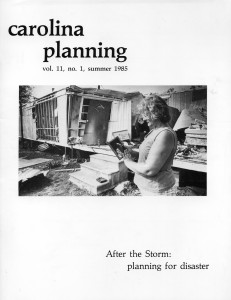 Volume 11.1 After the Storm: Planning for Disaster (1985)
Volume 11.1 After the Storm: Planning for Disaster (1985)
Crisis planning is, by its very nature, a paradoxical expression of the planning process. As planning professionals, we are accused of short-sightedness in the wake of community emergencies. This challenge to our purpose is, of course, familiar. We are accused of short-sightedness in our most routine zoning reviews. The planner’s dilemma? Indeed, we are prisoners of necessity and captives of precaution.
For the most part, the conflict associated with crisis planning and emergency planning is related to the frailties of the “long-range comprehensive process” which characterizes our mission. It is a conflict empowered and crippled by politics; a conflict of financial and social priorities. The “long-range” is discounted as a frivolous and unknowable perspective. “There is so much to be done now…”, the public bureaucracy cries, “how can we afford the luxury of a disaster plan?” Luxury becomes necessity only in the aftermath. The disaster provides for itself. Community response to life-threatening emergencies provides a context for future planning. In many cases, however, the unwanted education of one community is rarely exchanged with cities and towns still waiting their turn.
In this issue of Carolina Planning, some of the lessons of disaster and emergency planning are discussed.
Editors: Ted Olin Harrison, Stacey Ponticello, Laura Bachle, and Nancy E. Garner
A digital version of this issue is available here.
| THE BRIEF LIFE AND HARD TIMES OF THE COASTAL PLAINS REGIONAL COMMISSION
Dusenbury, Pat Dusenbury’s history of the Coastal Plains Regional Commission highlights the contributions of this federally funded agency and traces its demise. The article dismisses the notion that regional economic development planning is ineffective and suggests that its’ loss of commitment to planning and preoccupation with survival account for its end. |
| SHARING EMERGENCY PLANNING ASSUMPTIONS
Kartez, Jack; Hunter, Liese; Kelley, William Disaster planning programs and policies of 250 public agencies are reviewed. The study describes managerial perspectives of disaster planning. |
| HAZARD REDUCTION THROUGH DEVELOPMENT MANAGEMENT IN HURRICANE-PRONE LOCALITIES
Beatley, Timothy; Godschalk, David State of the art development management strategies are explored in a survey of hurricane prone localities in 19 states. Results show not only a high priority for hazard mitigation but also a high reliance on development management approaches vs. building, strengthening, and environmental alteration. |
| REDEVELOPMENT AFTER THE STORM: HAZARD MITIGATION OPPORTUNITIES AND OBSTACLES IN THE POST-DISASTER SETTING
Hegenbarth, Jane; Brower, David The authors detail obstacles and consequences of development management planning in disaster-prone areas. Sever storms can provide unique opportunities for developers and public recreation where the land has been naturally cleared. Several organizational problems exist for post-disaster communities. |
| JUSTICE IN THE COMMUNITY: STRATEGIES FOR DISPUTE RESOLUTION
Gelblum, Rob Gelblum’s article describes the role of dispute centers as an institutional source of conflict resolution. These organizations provide a framework for cooperative, negotiated dispute settlement. The Chapel Hill, North Carolina Dispute Settlement Center is presented as a case study. |